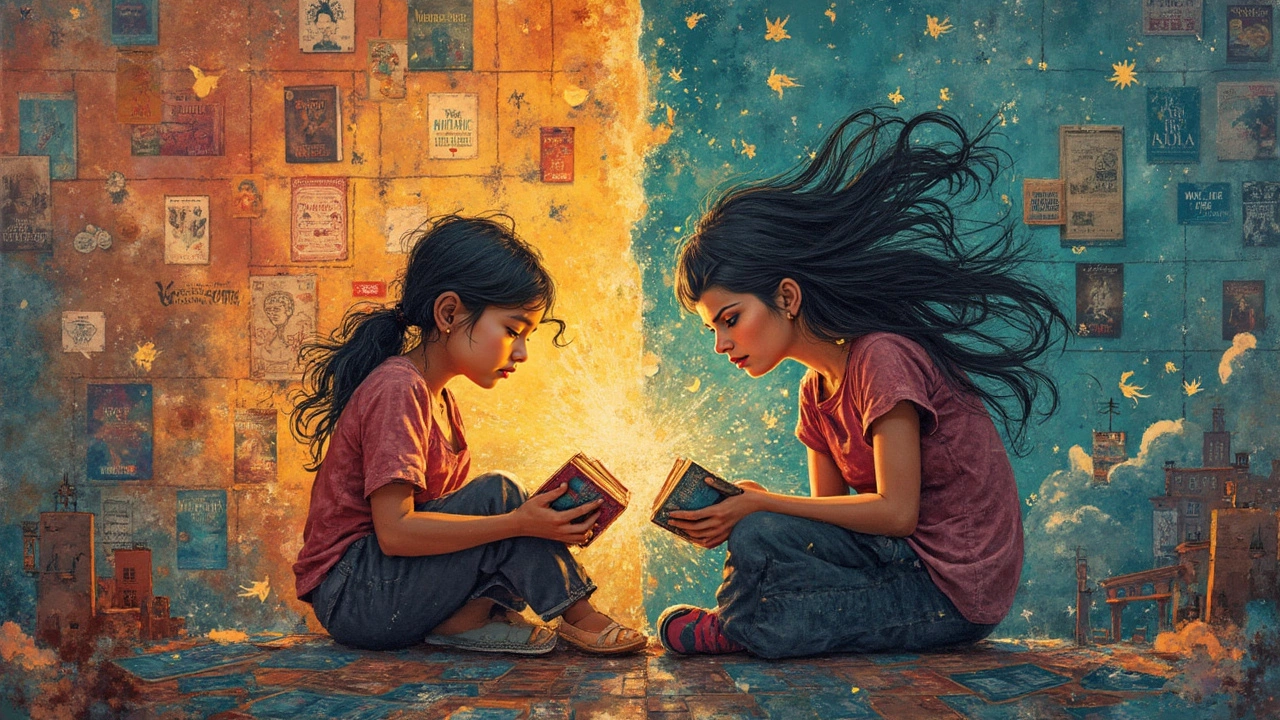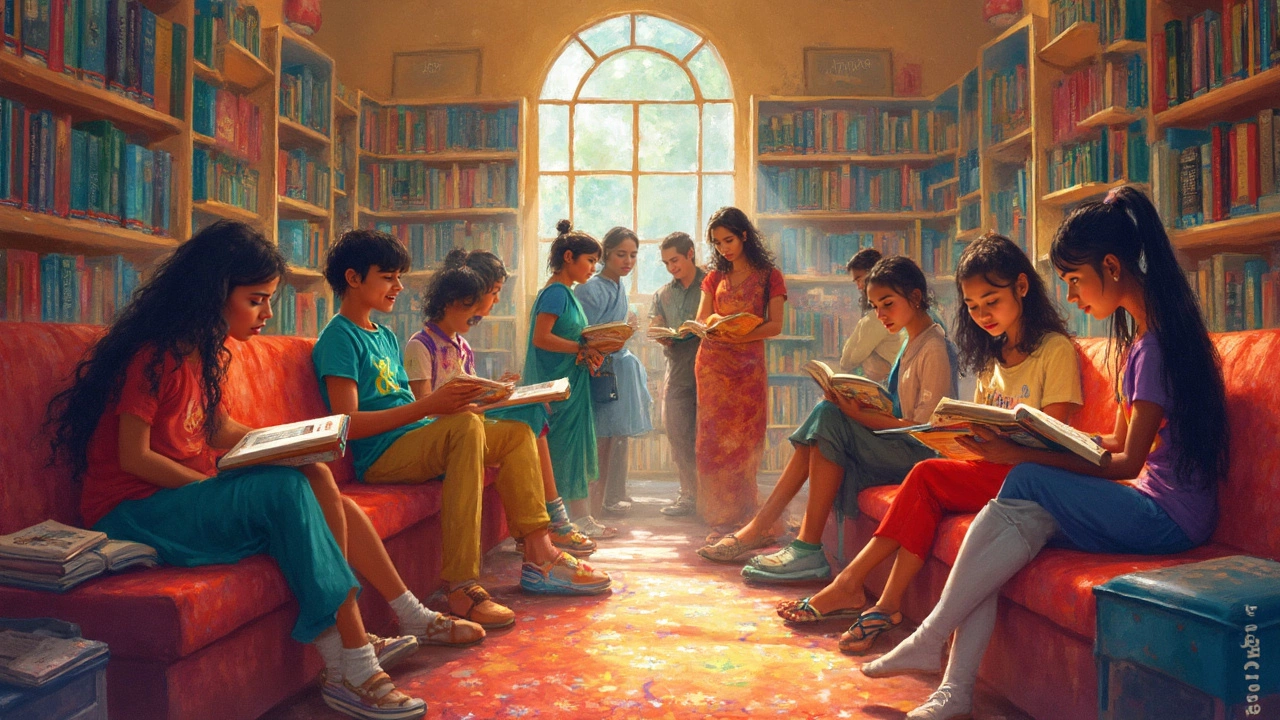The age range for YA—young adult—gets people talking more than you’d think. Everyone’s heard of YA, but who exactly are these books written for? Publishers usually slap a "12 to 18" or "13 to 18" age label on YA. But here’s the truth: it’s not a hard line. Some books lean younger, others go heavy on mature themes, and a few bridge the gap to college life.
If you’ve got a kid at home (like my son Quentin, who’s 12), picking books can feel like navigating a minefield. Too childish, and they roll their eyes. Too intense, and you might end up with some late-night questions you weren’t ready for. Librarians usually shelve YA for teens in middle and high school, but plenty of 10- or 19-year-olds find something for themselves in this zone.
- The Official YA Age Range
- Why Teens Aren’t the Only Readers
- YA vs Middle Grade vs New Adult
- How Content Affects Age Recommendations
- Tips for Choosing the Right YA Book
- Can YA Be for Adults Too?
The Official YA Age Range
This is probably the most common question when people first hear about young adult fiction: what’s the official age range? Most big publishers and libraries stick with ages 12 to 18 for their YA age range. That covers everything from early teens just starting middle school all the way up to high school seniors ready to head off to college.
The reason for that wide range is simple: YA books hit on experiences teens are dealing with—things like friendship drama, figuring out their identity, taking risks, and sometimes even dating (with all the awkward bits that come with it). These aren’t just books for older kids; they’re tuned in to what it feels like to be right in the middle of growing up.
If you’re curious about how age recommendations break down, here’s a quick look at what you’ll usually see on bookshelves:
- Middle Grade: 8–12 years old
- Young Adult (YA): 12–18 years old
- New Adult (NA): 18–25 years old
Some YA books skew young and are just right for 12- or 13-year-olds. Others, especially ones dealing with heavy themes, might really hit home with older teens. A handy fact: the American Library Association and Scholastic both set young adult fiction squarely at ages 12 to 18 in their guides.
Check out this handy comparison from two of the big organizations:
| Source | YA Age Range Listed |
|---|---|
| American Library Association (ALA) | 12–18 |
| Young Adult Library Services Association (YALSA) | 12–18 |
| Scholastic | 12–18 |
But don’t get too hung up on the numbers. Maturity, interests, and even where you live can swing the real age range one way or another. The main takeaway? YA age range means 12–18, but the spirit of these books lands wherever teens are figuring out who they are.
Why Teens Aren’t the Only Readers
It’s no secret that young adult fiction has a fan base way beyond just the 12 to 18 crowd. One striking fact: in the United States, surveys by publishing groups show that over half of YA books are bought by adults—most for themselves, not for a teen at home. So if you catch your neighbor, your aunt, or your kid’s soccer coach with a copy of a hit YA novel, don’t be surprised.
There’s a reason for this wide appeal. YA age range books tend to focus on fast-paced plots, relatable characters, first loves, and big choices—the kind of stuff everyone remembers from growing up. The writing is usually snappy, without all the padding and complicated language you sometimes see in adult books. People with busy lives (like parents or folks commuting on the train) like how easy it is to dive into these stories.
- YA fiction often tackles social issues—identity, family conflict, mental health, and justice—in a direct way. That honesty pulls in readers from all walks of life.
- The community around popular YA series (think movies, fandoms, online discussions) grows to include all ages. If you’ve ever lined up for a Harry Potter or Hunger Games release, you know those crowds aren’t just teenagers.
- Nostalgia hits hard. Adults sometimes want to relive or reflect on those intense teen years, and YA provides an easy doorway back.
Here’s a peek at who’s buying teen books:
| Age Group | % of YA Book Purchases |
|---|---|
| 12-18 | 38% |
| 19-29 | 28% |
| 30 and up | 34% |
So next time you see someone curled up with a YA novel, don’t assume their birth year. The stories just hit differently for different people, and that’s exactly why this category isn’t limited to one age group.
YA vs Middle Grade vs New Adult
Here's where a lot of people get tripped up. You see a book cover with a moody teen, and you’re not sure if it’s YA or middle grade. Or maybe you’ve heard of "new adult" and wondered if that’s just YA for grown-ups. Let’s break it down cleanly.
Middle grade (MG) books are typically for readers ages 8 to 12. These books tackle real-life issues but keep it pretty light—think friendship trouble, family shake-ups, or a spooky mystery that isn’t actually terrifying. The main characters are usually pre-teens. If your kid is into "Percy Jackson" or "Wonder," you’re firmly in MG land.
Young adult fiction (YA) kicks in around ages 12 or 13 and runs up to about 18. But that’s just the publisher label—plenty of younger or older kids dip in. YA books dig deeper into identity, relationships, and sometimes topics like mental health, sexuality, or trauma. The themes get heavier, but the heart is the same: characters figuring out who they are, often for the first time. Popular YA titles include "The Hunger Games," "The Fault in Our Stars," and "One of Us Is Lying."
Then you’ve got new adult (NA), which is a newer category aimed at readers around age 18 to their early 20s. NA stories often start where high school ends—college life, early jobs, first apartments, and the messiness of adulthood. They aren’t afraid of mature content or complicated relationships. NA got a boost from indie authors on Kindle, but traditional bookstores are still figuring out where to shelf these books.
To see the basic breakdown at a glance:
| Category | Typical Age | Main Characters’ Age | Common Themes |
|---|---|---|---|
| Middle Grade | 8–12 | 10–13 | Friendship, family, growing up |
| Young Adult | 12–18 | 13–18 | Identity, romance, tough topics |
| New Adult | 18–25 | 18–25 | Independence, college, adult issues |
So, MG isn’t just "easier" than YA—it’s different in tone, focus, and character age. And NA tops off where YA leaves off, following readers as they hit new life stages. Knowing these divisions helps you find the best book for the right age—truly the secret sauce for keeping young readers hooked.

How Content Affects Age Recommendations
There’s a reason why YA age range numbers swing between 12 and 18. It’s all about content. The stuff inside a YA book—language, topics, and how real it gets—shapes who should read it. Most YA books tap into problems teens face, like first love, friendships, family drama, or discovering who you are. But sometimes, a book dives deep into heavy or mature stuff. This can mean graphic violence, sex, mental health struggles, or strong language. That’s when age recommendations shift closer to the upper end, or even higher.
Publishers don’t use some magic formula for age ratings. They base decisions on:
- Language (is it PG or more R-rated?)
- Type of romance (is it crushes or steamy scenes?)
- Violence (a playground scuffle or end-of-the-world fights?)
- Mature topics (addiction, abuse, trauma)
For example, "The Hate U Give" by Angie Thomas is technically YA, but some schools shelve it for older teens because it covers police violence and has strong language. On the other hand, something like "Percy Jackson" is usually pushed toward younger teens and even strong readers in elementary school.
Here’s a quick comparison of content limits in popular kid/teen genres:
| Genre | Usual Age Range | Content |
|---|---|---|
| Middle Grade (MG) | 8–12 | Little to no swearing, innocent romance, mild danger |
| YA | 12–18 | Dating, family struggles, social issues, some swearing, more risk |
| New Adult (NA) | 18–25 | A lot of sex, intense themes, adult independence |
If you’re choosing books for someone in the YA age range, don’t just skim the jacket. Sometimes the cover looks like a teen movie, but the pages get way more intense. Always check reviews or sites like Common Sense Media. It saves a lot of awkward dinner convos. Oscar, my dog, can sense when one’s coming—he leaves the room!
Tips for Choosing the Right YA Book
Trying to find the perfect young adult fiction book for a specific age or interest? Here’s how I figure it out for my kids—nobody wants a book that’s way too young or a story packed with stuff you wish you’d known about first.
First, check the recommended YA age range on the back or inside cover. Publishers usually call out a range like "Ages 12-18," which is a good starting spot, but not perfect every time.
- Read reviews. Parents and teens on sites like Common Sense Media, Goodreads, and even Reddit will tell you whether a book is appropriate, not just entertaining. They’ll flag stuff like violence, language, or romance way better than the back cover does.
- Look at the main character’s age. If the protagonist is 16, expect high school-level drama and themes. If they’re 13, you’re probably getting a middle school vibe. Quentin always spots this quickly when picking out what fits where he’s at in life.
- Preview the first chapter. You can usually find free previews online. I’ll skim the start just to see if the language or setup feels right for my kid’s maturity (and sometimes for me if I want a breezy read that’s not too heavy).
- Don’t ignore the genre. Fantasy YA can skip a lot of real-world problems, but contemporary YA might dig into tough topics—grief, mental health, first love, bullying. Think about what your reader likes, but also what they’re ready for emotionally.
- Ask a librarian. These folks know their stuff. If you say "My 13-year-old hates romance but loves mysteries," you’ll get five spot-on recs in two minutes flat.
Here’s a quick comparison just to show how much a book’s content can vary, even if it’s all in the YA age range:
| Title | Main Character’s Age | Recommended Age | Main Themes |
|---|---|---|---|
| The Hunger Games | 16 | 12-18 | Dystopia, Survival, Rebellion |
| Eleanor & Park | 16 | 14-18 | Romance, Bullying, Family Issues |
| Wonder | 10 | 10-14 | Bullying, Friendship, Identity |
| They Both Die at the End | 17 | 14-18 | LGBTQ+, Mortality, Friendship |
Bottom line: don’t get hung up on a specific number. Focus on what your reader can handle and what makes them excited to turn the page. The right YA book should challenge a teen just enough—but not leave anyone lost or uncomfortable.
Can YA Be for Adults Too?
People love to argue about whether YA—young adult fiction—is just for teens. Here’s the truth: a ton of adults are reading YA. If you peek at bestseller lists, you’ll see YA titles climbing up there right next to adult thrillers and romance. Publishers Weekly reported that more than half of YA readers are over 18, and I know plenty of parents, teachers, and just regular grownups who don’t care one bit about the intended age group—they just want a good read.
What pulls adults into YA books? Some say it’s the pace—YA stories don’t mess around. You usually get straight into the nitty-gritty: the action, the awkward relationships, the big emotions. Plus, YA tends to skip dense descriptions and long-winded backstory, so you can knock out a whole book in a weekend. It’s not just lighter reads, either. Think of books like “The Hunger Games” or “The Hate U Give”—they tackle pretty real issues.
If you’re new to the genre, here’s why adults might end up loving YA books just as much as teens:
- Relatable themes: Identity, first love, belonging, and standing up for something—plenty of adults connect with those, regardless of age.
- Easy to jump into: Not everyone has hours to trudge through long novels after work or chasing kids/pets (Oscar, looking at you).
- Current conversations: YA often explores trending topics, like mental health, diversity, and social justice, sometimes even before adult fiction dives in.
- Variety of genres: Whether you’re into fantasy, romance, sci-fi, or contemporary, you’ll find it in YA.
One thing to remember is that not all YA books are squeaky clean or suitable for younger readers, but that doesn’t mean they’re childish. It’s normal to see adults reading them on the train or recommending them at book clubs. Plus, talking about YA books with teens is actually a killer way to connect. My daughter Thalia and I still argue over who had a better reading year (spoiler: she wins every time).
So, if you’re wondering if YA is only for a certain age group, the answer’s simple: not at all. The best YA books work for anyone who remembers the rollercoaster of growing up—or just wants to enjoy a fast-paced, gripping story.
| Reader Age Group | % of YA Books Sold |
|---|---|
| 12-17 years | 40% |
| 18-29 years | 24% |
| 30+ | 36% |

